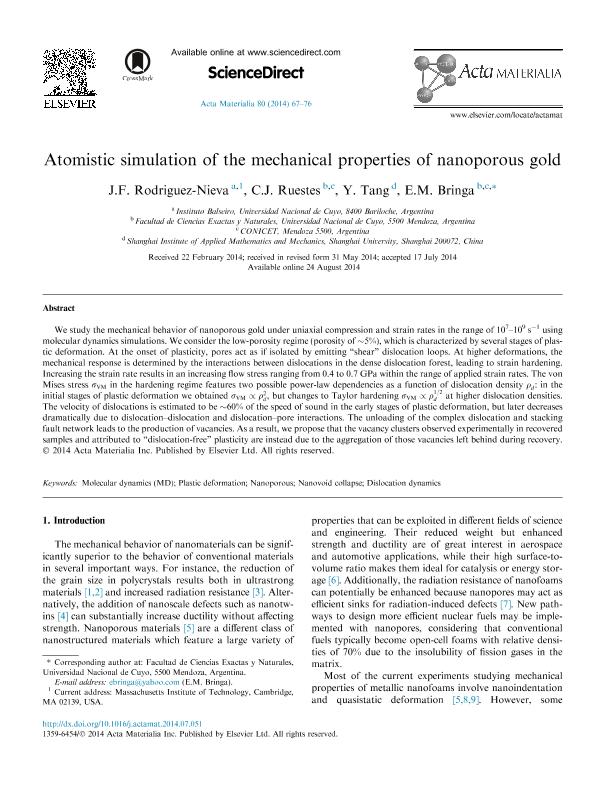Mostrar el registro sencillo del ítem
dc.contributor.author
Rodriguez Nieva. J. F.
dc.contributor.author
Ruestes, Carlos Javier

dc.contributor.author
Tang, Yizhe

dc.contributor.author
Bringa, Eduardo Marcial

dc.date.available
2018-01-03T21:30:19Z
dc.date.issued
2014-08
dc.identifier.citation
Bringa, Eduardo Marcial; Tang, Yizhe; Ruestes, Carlos Javier; Rodriguez Nieva. J. F.; Atomistic simulation of the mechanical properties of nanoporous gold; Elsevier; Acta Materialia; 80; 8-2014; 67-76
dc.identifier.issn
1359-6454
dc.identifier.uri
http://hdl.handle.net/11336/32241
dc.description.abstract
7–109 s−1 using molecular dynamics simulations. We consider the low-porosity regime (porosity of ∼5%), which is characterized by several stages of plastic deformation. At the onset of plasticity, pores act as if isolated by emitting “shear” dislocation loops. At higher deformations, the mechanical response is determined by the interactions between dislocations in the dense dislocation forest, leading to strain hardening. Increasing the strain rate results in an increasing flow stress ranging from 0.4 to 0.7 GPa within the range of applied strain rates. The von Mises stress σVM in the hardening regime features two possible power-law dependencies as a function of dislocation density ρd: in the initial stages of plastic deformation we obtained σVM∝ρd2, but changes to Taylor hardening σVM∝ρd1/2 at higher dislocation densities. The velocity of dislocations is estimated to be ∼60% of the speed of sound in the early stages of plastic deformation, but later decreases dramatically due to dislocation–dislocation and dislocation–pore interactions. The unloading of the complex dislocation and stacking fault network leads to the production of vacancies. As a result, we propose that the vacancy clusters observed experimentally in recovered samples and attributed to “dislocation-free” plasticity are instead due to the aggregation of those vacancies left behind during recovery.
dc.format
application/pdf
dc.language.iso
eng
dc.publisher
Elsevier

dc.rights
info:eu-repo/semantics/openAccess
dc.rights.uri
https://creativecommons.org/licenses/by-nc-nd/2.5/ar/
dc.subject
Molecular Dynamics (Md)
dc.subject
Plastic Deformation
dc.subject
Nanoporous
dc.subject
Nanovoid Collapse
dc.subject
Dislocation Dynamics
dc.subject.classification
Recubrimientos y Películas

dc.subject.classification
Ingeniería de los Materiales

dc.subject.classification
INGENIERÍAS Y TECNOLOGÍAS

dc.title
Atomistic simulation of the mechanical properties of nanoporous gold
dc.type
info:eu-repo/semantics/article
dc.type
info:ar-repo/semantics/artículo
dc.type
info:eu-repo/semantics/publishedVersion
dc.date.updated
2018-01-03T19:59:18Z
dc.journal.volume
80
dc.journal.pagination
67-76
dc.journal.pais
Países Bajos

dc.journal.ciudad
Ámsterdam
dc.description.fil
Fil: Rodriguez Nieva. J. F.. Massachusetts Institute of Technology; Estados Unidos. Comisión Nacional de Energía Atómica. Gerencia del Área de Energía Nuclear. Instituto Balseiro; Argentina
dc.description.fil
Fil: Ruestes, Carlos Javier. Universidad Nacional de Cuyo. Facultad de Ciencias Exactas y Naturales; Argentina. Consejo Nacional de Investigaciones Científicas y Técnicas. Centro Científico Tecnológico Conicet - Mendoza; Argentina
dc.description.fil
Fil: Tang, Yizhe. Shanghai University. Shanghai Institute of Applied Mathematics and Mechanics; China
dc.description.fil
Fil: Bringa, Eduardo Marcial. Consejo Nacional de Investigaciones Científicas y Técnicas. Centro Científico Tecnológico Conicet - Mendoza; Argentina. Universidad Nacional de Cuyo. Facultad de Ciencias Exactas y Naturales; Argentina
dc.journal.title
Acta Materialia

dc.relation.alternativeid
info:eu-repo/semantics/altIdentifier/url/http://www.sciencedirect.com/science/article/pii/S1359645414005692
dc.relation.alternativeid
info:eu-repo/semantics/altIdentifier/doi/http://dx.doi.org/10.1016/j.actamat.2014.07.051
Archivos asociados
